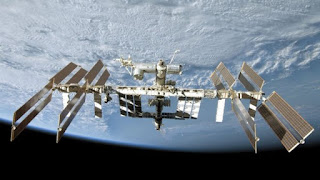Silver Keeps the ISS Healthy!
Silver
and ruthenium coating
to
get rid of the microbes!
Harmful
bacteria can survive in space under zero-gravity conditions. That can make for
some pretty unhealthy living and working conditions on the International Space
Station (ISS), which has been continually inhabited since November 2000.
One
of the areas which scientists found particularly rife with bacteria is the
toilet door. Such infestations are more dangerous for astronauts in space
because prolonged time in orbit has been shown to reduce a person’s immune
system. Microgravity, along with solar and cosmic radiation, changes the
immune-regulatory system of the crew, leaving them more susceptible to
pathogens.
“Spaceflight
can turn harmless bacteria into potential pathogens,” said senior study author
Elisabeth Grohmann of Beuth University of Applied Sciences, Berlin, in a
prepared statement.
“Just as stress hormones leave astronauts vulnerable to
infection, the bacteria they carry become hardier -developing thick protective
coatings and resistance to antibiotics and more vigorous, multiplying and
metabolizing faster.”
The
safest and perhaps simplest way to get rid of the microbes is a coating of
silver and ruthenium, according to astronauts who tested the new combination.
The surface coating is called AgXX. (Ruthenium is a rare metal belonging to the
platinum group of the periodic table and is inert to most other chemicals. The
element offers some antibacterial powers.) AgXX
works by killing bacteria as well as certain fungi, yeasts and viruses,
Grohmann noted. “The effects are similar to bleach except the coating is
self-regenerating, so it never gets used up.”
After
coating the door to the space toilet with AgXX, the space station astronauts
tested the surface for bacteria three times over a 19-month period. After the
first six months, the AgXX-coated surface remained bacteria-free. However, six
months later, nine strains of bacteria were found and three more strains were
discovered by the end of the study period.
In
the long term, the AgXX-coated surface had 80 percent fewer bacterial strains
compared to an uncoated area of bare steel.
Interestingly, the coating’s
germ-killing powers were lessened but not because the material itself became
less effective. Instead, a build-up of dust and dirt decreased the coating’s
ability to make contact with bacteria.
“With
prolonged exposure time a few bacteria escaped the antimicrobial action. The
antimicrobial test materials are static surfaces where dead cells, dust
particles and cell debris can accumulate over time and interfere with the
direct contact between the antimicrobial surface and the bacteria,” Grohmann
explained.
NASA
astronaut Serena Auñón-Chancellor, who handles plumbing aboard the ISS, said:
“Most importantly, no serious human pathogens such as Methicillin-resistant
Staphylococcus aureus (MRSA) or Vancomycin-resistant Enterococci (VRE) were
found on any surface. Thus, the infection risk for the crew is low.”
“Immunosuppressant,
bacterial virulence and therefore infection risk increase with duration of
spaceflight,” Grohmann added. “We must continue to develop new approaches to
combat bacterial infections if we are to attempt longer missions to Mars and
beyond.” The researchers’ results are in the journal Frontiers in Microbiology.







Comments
Post a Comment